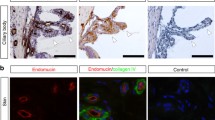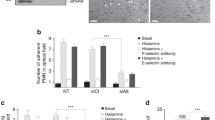Abstract
We have recently reported that the human lymphatic endothelium has toll-like receptor 4 (TLR4)-mediated lipopolysaccharide recognition mechanisms that induce the expression of intercellular adhesion molecule-1 (ICAM-1) and vascular cell adhesion molecule-1 (VCAM-1). Although ligand engagement with TLR2 enables activation of the MyD88-dependent pathway similarly to TLR4, whether TLR2 ligands such as lipoteichoic acid (LTA) trigger the activation of lymphatic endothelium remains unclear. This study has been designed to investigate the expression dynamics of LTA-induced leukocyte adhesion molecules and chemokines in cultured human lymphatic endothelium (LEC). Reverse transcription/polymerase chain reaction (RT-PCR) and real-time quantitative PCR analyses have shown that LEC usually expresses TLR2 and increases TLR2 gene expression on LTA treatment. Indeed, LTA-treated LEC increases the expression of E-selectin, ICAM-1, and VCAM-1 but does not alter the gene expression of ICAM-2, ICAM-3, junctional adhesion molecule-1 (JAM-1), JAM-3, or platelet endothelial cell adhesion molecule-1 (PECAM-1). The expression of LTA-induced E-selectin, ICAM-1, and VCAM-1 in LEC is suppressed by anti-TLR2 but not by anti-TLR4 and is also suppressed by TLR2-specific short interfering RNA (siRNA) but not by siRNA for TLR4. The expression of CCL2, CCL5, and CCL20 (Cys-Cys motif chemokines) and of CXCL1, CXCL3, CXCL5, CXCL6, and CXCL8 (Cys-X-Cys motif chemokines) was induced in LEC with LTA. These data suggest that the human lymphatic endothelial phenotype has TLR2-mediated LTA-recognition mechanisms, resulting in increased expression of inflammatory leukocyte adhesion molecules and phagocyte-attractive chemokines. The human lymphatic endothelium may thus function to collect leukocytes from tissues into lymphatic vessels by means of immunologically functional molecules.











Similar content being viewed by others
References
Aderem A, Ulevitch RJ (2000) Toll-like receptors in the induction of the innate immune response. Nature 406:782–787
Ahmad M, Theofanidis P, Medford RM (1998) Role of activating protein-1 in the regulation of the vascular cell adhesion molecule-1 gene expression by tumor necrosis factor-alpha. J Biol Chem 273:4616–4621
Combadiere C, Ahuja SK, Tiffany HL, Murphy PM (1996) Cloning and functional expression of CC CKR5, a human monocyte CC chemokine receptor selective for MIP-1(alpha), MIP-1(beta), and RANTES. J Leukoc Biol 60:147–152
Cook-Mills JM (2002)VCAM-1 signals during lymphocyte migration: role of reactive oxygen species. Mol Immunol 39:499–508
Dauphinee SM, Karsan A (2006) Lipopolysaccharide signaling in endothelial cells. Lab Invest 86:9–22
Doroshenko T, Chaly Y, Savitskiy V, Maslakova O, Portyanko A, Gorudko I, Voitenok NN (2002) Phagocytosing neutrophils down-regulate the expression of chemokine receptors CXCR1 and CXCR2. Blood 100:2668–2671
Dustin ML, Bivona TG, Philips MR (2004) Membranes as messengers in T cell adhesion signaling. Nat Immunol 5:363–372
Ebata N, Sawa Y, Nodasaka Y, Yamaoka Y, Yoshida S, Totsuka Y (2001) Immunoelectron microscopic study of PECAM-1 expression on lymphatic endothelium of the human tongue. Tissue Cell 33:211–218
Gong X, Gong W, Kuhns DB, Ben-Baruch A, Howard OM, Wang JM (1997) Monocyte chemotactic protein-2 (MCP-2) uses CCR1 and CCR2B as its functional receptors. J Biol Chem 272:11682–11685
Hijiya N, Miyake K, Akashi S, Matsuura K, Higuchi Y, Yamamoto S (2002) Possible involvement of toll-like receptor 4 in endothelial cell activation of larger vessels in response to lipopolysaccharide. Pathobiology 70:18–25
Into T, Kanno Y, Dohkan J, Nakashima M, Inomata M, Shibata K, Lowenstein CJ, Matsushita K (2007) Pathogen recognition by Toll-like receptor 2 activates Weibel-Palade body exocytosis in human aortic endothelial cells. J Biol Chem 282:8134–8141
Ishizuka T, Kawakami M, Hidaka T, Matsuki Y, Takamizawa M, Suzuki K, Kurita A, Nakamura H (1998) Stimulation with thromboxane A2 (TXA2) receptor agonist enhances ICAM-1, VCAM-1 or ELAM-1 expression by human vascular endothelial cells. Clin Exp Immunol 112:464–470
Jones SA, Dewald B, Clark-Lewis I, Baggiolini M (1997) Chemokine antagonists that discriminate between interleukin-8 receptors. Selective blockers of CXCR2. J Biol Chem 272:16166–16169
Kaisho T, Akira S (2002) Toll-like receptors as adjuvant receptors. Biochim Biophys Acta 1589:1–13
Kobuchi H, Roy S, Sen CK, Nguyen HG, Packer L (1999) Quercetin inhibits inducible ICAM-1 expression in human endothelial cells through the JNK pathway. Am J Physiol 277:C403–C411
Kuroshima S, Sawa Y, Kawamoto T, Yamaoka Y, Notani K, Yoshida S, Inoue N (2004) Expression of Toll-like receptors 2 and 4 on human intestinal lymphatic vessels. Microvasc Res 67:90–95
Lawson C, Ainsworth M, Yacoub M, Rose M (1999) Ligation of ICAM-1 on endothelial cells leads to expression of VCAM-1 via a nuclear factor-kappaB-independent mechanism. J Immunol 162:2990–2996
Liao F, Rabin RL, Smith CS, Sharma G, Nutman TB, Farber JM (1999) CC-chemokine receptor 6 is expressed on diverse memory subsets of T cells and determines responsiveness to macrophage inflammatory protein 3 alpha. J Immunol 162:186–194
Lien E, Ingalls RR (2002) Toll-like receptors. Crit Care Med 30:S1–S11
Lynch NJ, Roscher S, Hartung T, Morath S, Matsushita M, Maennel DN, Kuraya M, Fujita T, Schwaeble WJ (2004) L-ficolin specifically binds to lipoteichoic acid, a cell wall constituent of Gram-positive bacteria, and activates the lectin pathway of complement. J Immunol 172:1198–1202
Madge LA, Kluger MS, Orange JS, May MJ (2008) Lymphotoxin-a1b2 and LIGHT induce classical and noncanonical NF-kB-dependent proinflammatory gene expression in vascular endothelial cells. J Immunol 180:3467–3477
Nishibori M, Takahashi HK, Mori S (2003)The regulation of ICAM-1 and LFA-1 interaction by autacoids and statins: a novel strategy for controlling inflammation and immune responses.J Pharmacol Sci 92:7–12
O’Boyle G, Brain JG, Kirby JA, Ali S (2007) Chemokine-mediated inflammation: identification of a possible regulatory role for CCR2. Mol Immunol 44:1944–1953
Oertli B, Beck-Schimmer B, Fan X, Wuthrich RP (1998) Mechanisms of hyaluronan-induced up-regulation of ICAM-1 and VCAM-1 expression by murine kidney tubular epithelial cells: hyaluronan triggers cell adhesion molecule expression through a mechanism involving activation of nuclear factor-kappa B and activating protein-1. J Immunol 161:3431–3437
Ozinsky A, Underhill DM, Fontenot JD, Hajjar AM, Smith KD, Wilson CB, Schroeder L, Aderem A (2000) The repertoire for pattern recognition of pathogens by the innate immune system is defined by cooperation between toll-like receptors. Proc Natl Acad Sci USA 97:13766–13771
Page G, Lebecque S, Miossec P (2002) Anatomic localization of immature and mature dendritic cells in an ectopic lymphoid organ: correlation with selective chemokine expression in rheumatoid synovium. J Immunol 168:5333–5341
Polentarutti N, Introna M, Sozzani S, Mancinelli R, Mantovani G, Mantovani A (1997) Expression of monocyte chemotactic protein-3 in human monocytes and endothelial cells. Eur Cytokine Netw 8:271–274
Rajagopalan L, Rajarathnam K (2004) Ligand selectivity and affinity of chemokine receptor CXCR1. Role of N-terminal domain. J Biol Chem 279:30000–30008
Roebuck KA (1999) Oxidant stress regulation of IL-8 and ICAM-1 gene expression: differential activation and binding of the transcription factors AP-1 and NF-kappaB. Int J Mol Med 4:223–230
Rosen SD, Bertozzi CR (1994)The selectins and their ligands.Curr Opin Cell Biol 6:663–673
Sawa Y, Sugimoto Y, Ueki T, Ishikawa H, Sato A, Nagato T, Yoshida S (2007) Effects of TNF-alpha on leukocyte adhesion molecule expressions in cultured human lymphatic endothelium. J Histochem Cytochem 55:721–733
Sawa Y, Ueki T, Hata M, Iwasawa K, Tsuruga E, Kojima H, Ishikawa H, Yoshida S (2008) The LPS-induced IL-6, IL-8, VCAM-1, and ICAM-1 expression in human lymphatic endothelium. J Histochem Cytochem 56:97–109
Schacht V, Ramirez MI, Hong YK, Hirakawa S, Feng D, Harvey N, Williams M, Dvorak AM, Dvorak HF, Oliver G, Detmar M (2003) T1alpha/podoplanin deficiency disrupts normal lymphatic vasculature formation and causes lymphedema. EMBO J 22:3546–3556
Schroder NW, Morath S, Alexander C, Hamann L, Hartung T, Zaringer U, Goel UB, Weber JR, Schumann RR (2003) Lipoteichoic acid (LTA) of Streptococcus pneumoniae and Staphylococcus aureus activates immune cells via Toll-like receptor (TLR)-2, lipopolysaccharide-binding protein (LBP), and CD14, whereas TLR-4 and MD-2 are not involved. J Biol Chem 278:15587–15594
Springer TA (1994)Traffic signals for lymphocyte recirculation and leukocyte emigration: the multistep paradigm.Cell 76:301–314
Triantafilou M, Manukyan M, Mackie A, Morath S, Hartung T, Heine H, Triantafilou K (2004) Lipoteichoic acid and toll-like receptor 2 internalization and targeting to the Golgi are lipid raft-dependent. J Biol Chem 279:40882–40889
Ueki T, Iwasawa K, Ishikawa H, Sawa Y (2007) Expression of junctional adhesion molecules on the human lymphatic endothelium. Microvasc Res 75:269–278
Uematsu S, Akira S (2006) Toll-like receptors and innate immunity. J Mol Med 84:712–725
Uguccioni M, D’Apuzzo M, Loetscher M, Dewald B, Baggiolini M (1995) Actions of the chemotactic cytokines MCP-1, MCP-2, MCP-3, RANTES, MIP-1 alpha and MIP-1 beta on human monocytes. Eur J Immunol 25:64–68
Van Damme J, Wuyts A, Froyen G, Van Coillie E, Struyf S, Billiau A, Proost P, Wang JM, Opdenakker G (1997) Granulocyte chemotactic protein-2 and related CXC chemokines: from gene regulation to receptor usage. J Leukoc Biol 62:563–569
Varki A (1994) Selectin ligands.Proc Natl Acad Sci USA 91:7390–7397
White JR, Lee JM, Young PR, Hertzberg RP, Jurewicz AJ, Chaikin MA, Widdowson K, Foley JJ, Martin LD, Griswold DE, Sarau HM (1998) Identification of a potent,selective non-peptide CXCR2 antagonist that inhibits interleukin-8-induced neutrophil migration. J Biol Chem 273:10095–10098
Wolf M, Delgado MB, Jones SA, Dewald B, Clark-Lewis I, Baggiolini M (1998) Granulocyte chemotactic protein 2 acts via both IL-8 receptors, CXCR1 and CXCR2. Eur J Immunol 28:164–170
Wuyts A, Proost P, Lenaerts JP, Ben-Baruch A, Van Damme J, Wang JM (1998) Differential usage of the CXC chemokine receptors 1 and 2 by interleukin-8, granulocyte chemotactic protein-2 and epithelial-cell-derived neutrophil attractant-78. Eur J Biochem 255:67–73
Zeuke S, Ulmer AJ, Kusumoto S, Katus HA, Heine H (2002) TLR4-mediated inflammatory activation of human coronary artery endothelial cells by LPS. Cardiovasc Res 56:126–134
Author information
Authors and Affiliations
Corresponding author
Rights and permissions
About this article
Cite this article
Sawa, Y., Tsuruga, E., Iwasawa, K. et al. Leukocyte adhesion molecule and chemokine production through lipoteichoic acid recognition by toll-like receptor 2 in cultured human lymphatic endothelium. Cell Tissue Res 333, 237–252 (2008). https://doi.org/10.1007/s00441-008-0625-5
Received:
Accepted:
Published:
Issue Date:
DOI: https://doi.org/10.1007/s00441-008-0625-5




